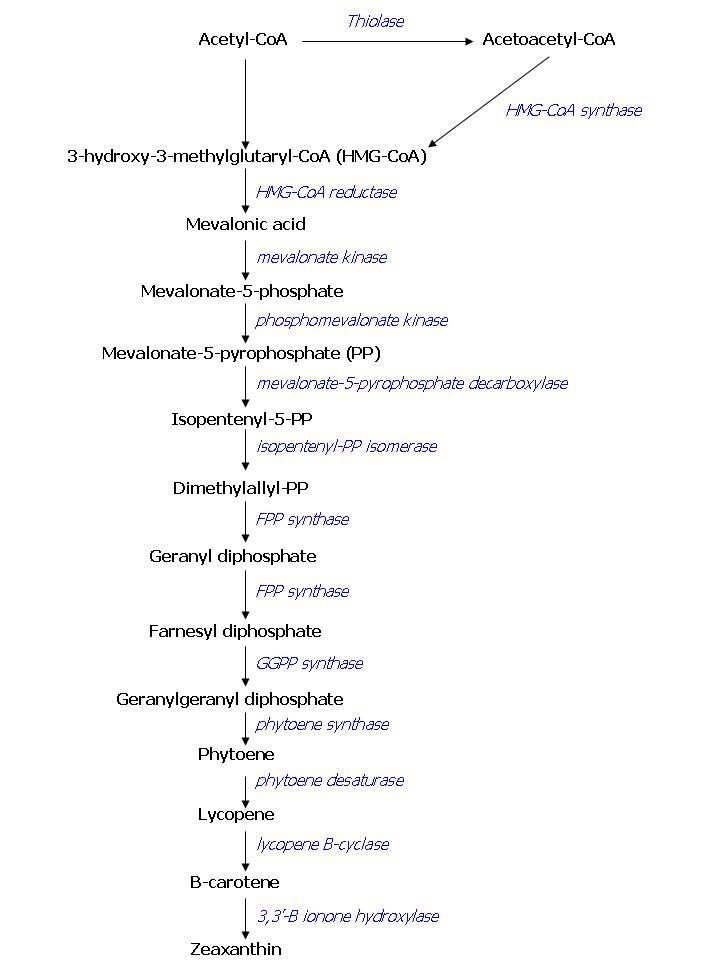Team:TUDelft/Color overview
From 2008.igem.org
(→Color output) |
(→Color output) |
||
| Line 9: | Line 9: | ||
There are two ways to overexpress FPP. First of all, the endogenous DXP pathway of ''E. coli'' could be overexpressed. However, it has been shown that this is not very efficient[http://www.biochemj.org/bj/324/0421/3240421.pdf][http://www3.interscience.wiley.com/cgi-bin/fulltext/77002141/PDFSTART]. Alternatively, we could try to engineer part of the mevalonate pathway of Saccharomyces cerevisiae into ''E. coli'' together with a few other S. cerevisiae and ''E. coli'' enzymes. It has been shown that this is an effective strategy to overproduce FPP in ''E. coli'' [http://www.nature.com/nbt/journal/v21/n7/pdf/nbt833.pdf]. An overview of the enzymes involved in the production of FPP is present in figure 1, at the bottom of this page. Once overproduction of FPP is achieved, we can focus on making a color or smell. To do this, we want to use the BioBricks created by the Edinburgh team last year in their self-flavoring yoghurt project. | There are two ways to overexpress FPP. First of all, the endogenous DXP pathway of ''E. coli'' could be overexpressed. However, it has been shown that this is not very efficient[http://www.biochemj.org/bj/324/0421/3240421.pdf][http://www3.interscience.wiley.com/cgi-bin/fulltext/77002141/PDFSTART]. Alternatively, we could try to engineer part of the mevalonate pathway of Saccharomyces cerevisiae into ''E. coli'' together with a few other S. cerevisiae and ''E. coli'' enzymes. It has been shown that this is an effective strategy to overproduce FPP in ''E. coli'' [http://www.nature.com/nbt/journal/v21/n7/pdf/nbt833.pdf]. An overview of the enzymes involved in the production of FPP is present in figure 1, at the bottom of this page. Once overproduction of FPP is achieved, we can focus on making a color or smell. To do this, we want to use the BioBricks created by the Edinburgh team last year in their self-flavoring yoghurt project. | ||
| - | [[Image:TUDelftPathway.jpg|thumb|center|figure 1. Color pathway as it will be introduced into | + | [[Image:TUDelftPathway.jpg|thumb|center|figure 1. Color pathway as it will be introduced into ''E. coli''. Products in black, enzymes in blue and italics.]] |
{{Template:TUDelftiGEM2008_sidebar}} | {{Template:TUDelftiGEM2008_sidebar}} | ||
Revision as of 13:09, 27 October 2008
Color output
A lot of the color and aroma compounds that occur in nature are derived from a common precursor: Farnesyl PyroPhosphate (FPP). FPP is a natural occurring molecule in Eschirichia coli but it is present in very small amounts. E. coli uses the FPP to incorporate into its cell membrane. To enable cells to express color and aroma compounds in easily detectable amounts it is necessary to overexpress FPP. There is a downside to this, however, as FPP is toxic to E. coli. This means FPP has to be drained constantly. We will do that by producing either a color or an aroma, but it also means we need to tune FPP expression so that it does not accumulate in the cells.
There are two ways to overexpress FPP. First of all, the endogenous DXP pathway of E. coli could be overexpressed. However, it has been shown that this is not very efficient[http://www.biochemj.org/bj/324/0421/3240421.pdf][http://www3.interscience.wiley.com/cgi-bin/fulltext/77002141/PDFSTART]. Alternatively, we could try to engineer part of the mevalonate pathway of Saccharomyces cerevisiae into E. coli together with a few other S. cerevisiae and E. coli enzymes. It has been shown that this is an effective strategy to overproduce FPP in E. coli [http://www.nature.com/nbt/journal/v21/n7/pdf/nbt833.pdf]. An overview of the enzymes involved in the production of FPP is present in figure 1, at the bottom of this page. Once overproduction of FPP is achieved, we can focus on making a color or smell. To do this, we want to use the BioBricks created by the Edinburgh team last year in their self-flavoring yoghurt project.
 "
"
